After several exciting weeks in Peru, we were on our way from Puno south to La Paz, the capital of Bolivia by bus via beautiful Lake Titicaca.
Whenever we've traveled by bus in the past from one country to another, it has always been an easy procedure. It's been just a matter of staying on the bus while immigration officers from each country look through everyone's documents or hopping off the bus at the border and going through the paperwork at the offices.
However, at the Peruvian border town of Desaguadero, the bus driver told everyone to get off in town and walk to the border which was a good six to eight blocks away. Thank goodness there was someone on the bus who was with a tour group as that person knew where to go as there were no signs anywhere otherwise directing us to the border.
There were lots of tuk tuks just like we'd seen all over Asia.
There was a whole line of currency traders just outside the Peru emigration office so Steven got rid of our last soles, Peru's currency,
Our 'Welcome to Bolivia' turned out to be not very auspicious!
What a sad sight seeing this old woman begging for money as we stood in line at the Bolivian immigration office.
Bolivia was one of only two countries we had had to mail our passports away to get a visa in advance for our 3.5 month long trip. Once we got our visas stamped, it was then an at least half-mile walk through a no man's land with again no signs anywhere directing us where to go to reach the bus for our onward journey to La Paz.
The no man's land looked like scenes from a war ravaged country; no businesses appeared to have been open in years and no people were present except our straggly line of people from the bus plodding ahead with no idea where we were going and how far away the bus would be. We kept hoping that the person in front knew something more than we did!
The end of the road took us fittingly enough to a cemetery of all places!
There we waited and waited for at least forty-five minutes hoping that all our possessions we'd left on the bus two hours earlier were still safe and sound as we'd had no idea we'd be separated from them for so long. Our stops at both the Peruvian and Bolivian crossings took only a few minutes each but the two hour time frame from the time we got off the bus and then back on was the worst we ever hope to have. I wondered how a handicapped person or older people could possibly have fared with what we had to go through.
There was one depressing community after another on our drive toward La Paz.
But the far away views of the Royal Andes Mountains were spectacular.
Nearing La Paz, we kept seeing red-brick building after red-brick building that appeared to be only half finished and wondered why.
It all seemed very desolate and depressing to me.
I overheard someone say the buildings were left unfinished so people wouldn't have to pay taxes and the red bricks were called barraca stones.
A statue of Che Guevara, the Argentine Marxist revolutionary who was a major figure in the Cuban Revolution who had spent a year in the de facto capital, was in a major square on the outskirts of the city. Sucre, a city we'd be visiting soon, is Bolivia's constitutional capital.
There were more alpaca shops than you could shake a stick at!
One of La Paz’s most important and historical landmarks and just a five minute walk from our hotel is the Iglesia de San Francisco, also known as the San Francisco Basilica. It predated the founding of La Paz by a year. Construction on the church, dedicated to St. Francisco of Assisi, started in 1548. When heavy snows caused it to collapse in 1610, more than 170 years passed before it was rebuilt. The church was a blend of cultures: Bolivian native and Catholic art. Its Baroque exterior was decorated with native symbols, including birds, snakes and dragons.
Unfortunately, the lovely church was not a place for silent prayer and reflection because of the huge din from the large crowd just outside on the plaza.
Though La Paz was founded in Laja in 1548, it and its Spanish inhabitants moved across the river the following year. The Franciscans built a bridge to join the Spanish and indigenous populations, an event that marked the beginning of the Franciscan Order's commitment to the excluded and impoverished people of La Paz.
The guide escorted us to the monastery's roof through a narrow stairway.
From the roof we had a lovely view of the church's bell tower and the Plaza San Francisco far below. I looked for Steven but couldn't find him!
The walk down the narrow, dark stone steps looked even gloomier going back as there was far less light at the 'end of the tunnel.'
Once back on the plaza and before I had a chance to see Steven, a young man interviewed me, in English luckily, about my thoughts about La Paz. I told him we had just arrived so couldn't say much but I looked forward to discovering his city!
Beside the Palace was a relatively recent addition to La Paz's religious structures, the Cathedral constructed in 1835. It was impressive in its own right but also because it was built on a steep hillside so the main entrance was about 40 feet higher than its base on another street!
The main attraction was the profusion of stained-glass work. The windows behind the altar, below, depicted a gathering of Bolivian political heavyweights being blessed from above by a flock of heavenly admirers.
This appeared to be the biggest confessional I had ever seen!
As we sat to get our breath and to enjoy the pretty square, we both thought we'd heard the telltale sound of an ice cream truck. Alas, when we looked around, it was the city garbage truck making its rounds!
As we made our way back to the hotel, I couldn't help but admire the selection of homemade pies in a shop window on the square.
The stunning Museo Nacional del Arte, kitty corner to the Cathedral, was constructed in 1775 of pink Viacha granite and was restored to its original grandeur in mestizo baroque and Andino baroque styles. We hoped to return to visit it another day as it was about to close.
Even only being in La Paz for a few hours, it was clear to see that locals had a well developed sweet tooth judging from all the stalls selling candy and cookies galore we'd already seen.
The same pedestrian mall we'd walked on earlier was even busier as people came out to buy food, household goods, clothing and, of course, candy!
Next post: A walking tour through a witches market and learning about the San Pedro prison, the only prison in South America run by its inmates, and much more!
Posted on February 21st, 2018, in Littleton, Colorado.
Whenever we've traveled by bus in the past from one country to another, it has always been an easy procedure. It's been just a matter of staying on the bus while immigration officers from each country look through everyone's documents or hopping off the bus at the border and going through the paperwork at the offices.
However, at the Peruvian border town of Desaguadero, the bus driver told everyone to get off in town and walk to the border which was a good six to eight blocks away. Thank goodness there was someone on the bus who was with a tour group as that person knew where to go as there were no signs anywhere otherwise directing us to the border.
There were lots of tuk tuks just like we'd seen all over Asia.
There was a whole line of currency traders just outside the Peru emigration office so Steven got rid of our last soles, Peru's currency,
Our 'Welcome to Bolivia' turned out to be not very auspicious!
What a sad sight seeing this old woman begging for money as we stood in line at the Bolivian immigration office.
Bolivia was one of only two countries we had had to mail our passports away to get a visa in advance for our 3.5 month long trip. Once we got our visas stamped, it was then an at least half-mile walk through a no man's land with again no signs anywhere directing us where to go to reach the bus for our onward journey to La Paz.
The no man's land looked like scenes from a war ravaged country; no businesses appeared to have been open in years and no people were present except our straggly line of people from the bus plodding ahead with no idea where we were going and how far away the bus would be. We kept hoping that the person in front knew something more than we did!
The end of the road took us fittingly enough to a cemetery of all places!
There we waited and waited for at least forty-five minutes hoping that all our possessions we'd left on the bus two hours earlier were still safe and sound as we'd had no idea we'd be separated from them for so long. Our stops at both the Peruvian and Bolivian crossings took only a few minutes each but the two hour time frame from the time we got off the bus and then back on was the worst we ever hope to have. I wondered how a handicapped person or older people could possibly have fared with what we had to go through.
There was one depressing community after another on our drive toward La Paz.
But the far away views of the Royal Andes Mountains were spectacular.
Nearing La Paz, we kept seeing red-brick building after red-brick building that appeared to be only half finished and wondered why.
It all seemed very desolate and depressing to me.
I overheard someone say the buildings were left unfinished so people wouldn't have to pay taxes and the red bricks were called barraca stones.
A statue of Che Guevara, the Argentine Marxist revolutionary who was a major figure in the Cuban Revolution who had spent a year in the de facto capital, was in a major square on the outskirts of the city. Sucre, a city we'd be visiting soon, is Bolivia's constitutional capital.
La Ciudad de Nuestra de La Paz - the City of Our Lady of Peace - was founded in 1548 by a Spaniard, Captain Alonzo de Mendoza. The community in the rugged canyon had been occupied by Aymara miners but the Spanish didn't waste any time seizing the gold mines. In spite of its name, the City of Our Lady of Peace has seen a good deal of violence. Since Bolivia, named after Simon Bolivar whom I wrote so much about in the Colombia posts, gained independence in 1825, the republic has endured more than 190 changes of leadership!
The altitude of La Paz, the highest national capital in the world, ranged from 13,313 ft above sea level in El Alto, the area that contained the airport and all the red brick buildings we'd just seen, to 10,170 ft in the bowl where the city sits. The bowl was surrounded by the high mountain peaks of the Altiplano, with triple-peaked Illimani towering over the city.
Just outside our hotel in the heart of the city was a street chocker block full of artisans' handicrafts. Unlike cities and towns we'd been in Peru, there was a large contingent of young people sitting on the street making bracelets, etc to scrape by.There were more alpaca shops than you could shake a stick at!
One of La Paz’s most important and historical landmarks and just a five minute walk from our hotel is the Iglesia de San Francisco, also known as the San Francisco Basilica. It predated the founding of La Paz by a year. Construction on the church, dedicated to St. Francisco of Assisi, started in 1548. When heavy snows caused it to collapse in 1610, more than 170 years passed before it was rebuilt. The church was a blend of cultures: Bolivian native and Catholic art. Its Baroque exterior was decorated with native symbols, including birds, snakes and dragons.
The beautifully decorated church, admired for its intricately carved facade and blending of Catholic and native art, was built entirely by indigenous Aymara workers.
As one of the city's focal points, the plaza of the same name is often the staging ground for rallies and protests. Something huge was going on that day but we didn't know what.
San Francisco Church was popular with both the Spanish and the local Aymara people. However, because it was unthinkable for the Aymara and Spanish to mix, a separate entrance was built for the Spanish, accessible only from a bridge crossing the river. The church was named after its founder, Francisco de los Angeles Morales, whose remains were entombed in the church.
The interior had gold-leaf decorated, small cedar chapels. Unfortunately, the lovely church was not a place for silent prayer and reflection because of the huge din from the large crowd just outside on the plaza.
Adjacent to the basilica were the cloisters and garden that had belonged to the monastery. Between 1965 and 2005, the church and monastery were restored, and part of the monastery was opened as the Museo San Francisco. I was interested in touring the Museo but Steven preferred to sit in the square. The guide mentioned to me and the other two visitors that the bright blue shade seen throughout the monastery was the artist's way of reminding people of how close the church was to the sky and, by extension, God.
Even appreciating the artist's philosophy, I still had difficulty wrapping my head around the psychedelic blue depiction of Christ done in this century.
Views of the monastery from the courtyard:
No monastery would have been complete without wine-making facilities.
I learned in the Our Lady of the Angels Gallery that the Protestant Reformation of northern Europe that avoided the use of images of the Virgin Mary, provoked a reaction from Catholics who intensified their devotion of Mary. As a result, canvases and images of the Virgin Mary filled churches in Europe and the Americas. The room exhibited heavenly paintings from the 17th to 19th centuries from different schools of painting. However, I had to be very circumspect taking photos here as I had also had to in the church.
In one of the long hallways were the bases of columns from 1549.
Though La Paz was founded in Laja in 1548, it and its Spanish inhabitants moved across the river the following year. The Franciscans built a bridge to join the Spanish and indigenous populations, an event that marked the beginning of the Franciscan Order's commitment to the excluded and impoverished people of La Paz.
The guide escorted us to the monastery's roof through a narrow stairway.
From the roof we had a lovely view of the church's bell tower and the Plaza San Francisco far below. I looked for Steven but couldn't find him!
One of the most interesting roofs I had ever seen was the church’s rooftop as it was made from unevenly-shaped tiles, in the ‘estilo muslera’ or 'thigh style.' In this method of making tiles, workers used their own thighs as the mold for the tiles, which turned out all different sizes, depending on the leg size of the worker!
The walk down the narrow, dark stone steps looked even gloomier going back as there was far less light at the 'end of the tunnel.'
Once back on the plaza and before I had a chance to see Steven, a young man interviewed me, in English luckily, about my thoughts about La Paz. I told him we had just arrived so couldn't say much but I looked forward to discovering his city!
Seeing this effigy in the plaza made us wonder what we had gotten into, coming to la Paz.
The street art we came across in the downtown core was very political.
We walked down a pedestrian-only street toward Plaza Murillo, the location of the Presidential Palace and the Cathedral.
In the large square was the stately Congress building and
the Presidential Palace. More on both of these buildings in the next post when we took one of the best, even if longest, walking tours of anywhere in the world!
As always, click on any photo to enlarge it so you can see it in greater detail.
A blight in my opinion on the architectural colonial harmony of Plaza Murillo was the ugly skyscraper being built directly behind the Presidential Palace.
The square was an enjoyable place to be in the late afternoon. It was fun watching the locals enjoying their time or even peddling their wares.
As we sat to get our breath and to enjoy the pretty square, we both thought we'd heard the telltale sound of an ice cream truck. Alas, when we looked around, it was the city garbage truck making its rounds!
As we made our way back to the hotel, I couldn't help but admire the selection of homemade pies in a shop window on the square.
The stunning Museo Nacional del Arte, kitty corner to the Cathedral, was constructed in 1775 of pink Viacha granite and was restored to its original grandeur in mestizo baroque and Andino baroque styles. We hoped to return to visit it another day as it was about to close.
Even only being in La Paz for a few hours, it was clear to see that locals had a well developed sweet tooth judging from all the stalls selling candy and cookies galore we'd already seen.
The same pedestrian mall we'd walked on earlier was even busier as people came out to buy food, household goods, clothing and, of course, candy!
Next post: A walking tour through a witches market and learning about the San Pedro prison, the only prison in South America run by its inmates, and much more!
Posted on February 21st, 2018, in Littleton, Colorado.














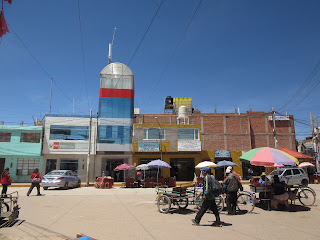

























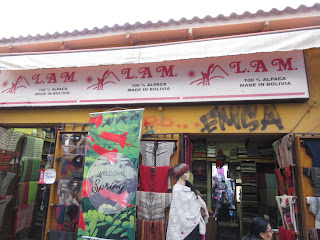

















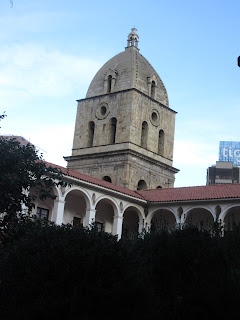















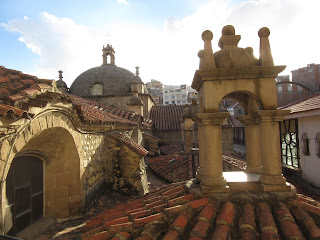









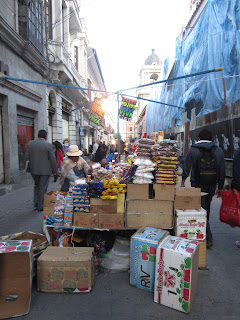
























No comments:
Post a Comment